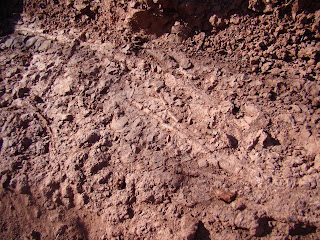Kim Beck's students at Seymour High School have been following the HMNS dig team's progress this week on the blog, and they sent Dr. Bakker and the rest of the team some great questions about what has been happening. Around the breakfast table before today's dig, he had these answers for them: When he discovered it,
Professor E. D. Cope named it Earth Lizard (
Edapho = Earth,
Saurus = Lizard.) "Daffy" is a nickname given to
Edaphosaurus by my professor at Harvard, Al Romer, who liked this species very much. Yes, some professors at Harvard have a sense of humor.
From
Chelsea D.: What was the use of
Lysorophian's long body?
Snaking through the soil or mud - similar to the way today's
salamanders. Many amphibians today have small bodies. This species also had a nasty bite, much like today's short legged
amphibians. These seem to go together.
From Edder J.: What is your favorite dinosaur? What is the coolest thing you've found?
Well, what we are digging in
Seymour were actually alive even before the dinosaurs. My favorite Red Beds species is The Texas Snotnose - known officially as the
Dasyceps. They had huge mucus glands, tiny teeth and very weak jaws.
The coolest thing we've found are the multiple layers of victims - showing us that the bones are still organized together, not jumbled up as previously thought. The pattern of
coprolite we've found is also very interesting.
In North Texas, you'd likely have a species called the Southern Mammoth. They were huge - over 13 feet tall at the shoulders.
From Nick W.: How many dinosaurs have you found?
From
Ashley H.: I want to learn more about the ocean and the animals that live in the sea. Also, I would like to learn about the
crinoid.
300 million yers ago in Texas, the ocean was very warm, with huge reefs that are full of critters. But there were no whales, modern sharks or even many clams - though there were plenty of
brachiopods. There were, however, thousands upon thousands of beautiful things that look like plants, but were actually animals - crinoids. They were like a
starfish turned upsidown. Some - such as
feather stars - are still alive today. They're very graceful and otherworldly. If you ever get to D.C., there is a beautiful display of crinoids at the
Smithsonian.
From Hunter D. and Veronica G.: How many years of college did you have to go to be a paleontologist? What is the greatest thing you have discovered?
I've got 9, but there are some very good paleontologists who learned on their own. It certainly helps to study biology, as the species alive today are often the descendants of the fossils we find. I'd say 6 years is a good number to shoot for - that would give you a Master's level degree in the field.
The greatest thing I've discovered is that CSI works to help us figure out who ate whom. For example,we now have evidence that, at least at some places, some times,
Dimetrodon ate
Xenacanthus sharks.
From Hunter H., Kevin P., Taylor G., and Jacob R.: How do you carbon date a fossil?
If you're lucky, the soil your fossil came from has traces of radioactive volcanic ash. The minerals in such ash start to decay right away, at predictable rates. If you've got the right machine, it can tell you how long the material has been decaying. But, we can't use carbon dating at the Seymour site - it doesn't allow us to date far enough back in time. Here, we compare what we are finding to similar fossils at sites that can be dated, for approximate ages.
From J.S.: What is so interesting about rock fossils?
They speak to us of times far, far away. It's like going on a time safari to another world.
From Jacey B. and Kelce S.: How can you figure out so much about something just by seeing parts of the fossil? How do you choose the sites you want to dig?
Mostly, the parts are bones, but they have marks on them where the muscles and ligaments were attached. Ribs can tell you how big the guts were. A braincase can tell you the size of the eyes, and about the sense of hearing and smell. Claws can tell you if the animal was capable of digging or climbing. We also have footprints - which can tell you how an animal walked, among other things - and coprolite, which can tell you where and what an animal was eating.
The site we're digging this week was easy to pick - it has been known as a locality for Permian fossils since 1882. And we've found new ones.
Also from Jacey B. and Kelce S.: Is it hard to tell if something is a fossil or just a rock?What killed all the dinosaurs?
To tell if a rock is a fossil, you need a hand lens. With one, you can see the microscopic structure of the bone - the holes left by blood vessels, spots where the muscles attached and in some cases, with a really good microscope, the bone crystals as well.
We don't have dinosaurs at this site - they came later in time - but we do have evidence of the first mass extinction. At the end of this period, all teh big herbivores were gone. The weather changed worldwide, becoming really, really dry. Nasty, nasty - salt flats and salt ponds. Horrible.
From Ryan M.: How much did Dimetrodon weigh?
We have three kinds of Dimetrodon. The really big one weighed as much as a really big tiger - about 600 pounds. Some of the little ones weighed no more than 60 pounds. So, it was like cat family of today - which has giant cats, bobcats and housecats.
From
Matt P. and
Tarrington R.: Have you ever found a complete
Seymouria fossil?
No, but my friend Dr. David Berman has found 4 - in Pittsburgh and in Germany. All of them were curled up in theri burrows, nose to tail, every bone in place.
From Kaitlin N.: Does it take a college degree to be a paleontologist?
Usually, yes. But many of the people who clean fossils and help with exhibits don't have advanced degrees.
From Clarence F.: Is paleontology fun and easy?
Yes, because you get bitten by ants and chased by millipedes, bitten by chiggers and poked by 3 kinds of cactus. Yes, because you get to look back through time, millions and millions of years to see all kinds of weird and wonderful and wonderful.
Is it easy? No. It's hard. But it's fun hard.
From Aaron B., Kyle H. and Callie P.: What feeling do you get when you discover a new species? What do you use to dig in the soil? How many fossils, on average, do you find per dig?
We laugh, we cry, we fall over. It's like shining a light into a dark, magic place and finding something looking back out at you.
For digging, the most important tools are your eyes, your fingertips and your feet. For non body-parts, the most important is good glue - you need to stabilize the fossil before you can dig. You also need scrapers and brushes. And Ziploc bags.
Here, we find lots of fossils on every dig. Up to hundreds of individual bones.
Several of the students were fascinated by David Temple's diverse background - including his talent for cooking bugs.
From Brandon T.: What do bugs taste like?
Generally, the flavors are very mild and most dishes that incorporate insects are flavored, so in general they taste like what ever you cook them with. There are a few exceptions, I once tried a cockroach that was roasted and seasoned with Tony Chachere’s Creole seasoning prepared by D. G. Gordon, I didn’t care for it, there wasn’t enough of that cajun spice in Louisiana to mask that taste. (Tony Chachere's is a good choice for bug cooking and as the company’s own claim states- “Good on everything” )
From Carrie H.: What does it take to make chocolate covered crickets and grasshoppers, and how long?
Chocoate covered insects are fast and easy, Let’s say you wake up one morning with a powerful craving for chocolate covered crickets. First catch or purchase some crickets, ideally you want to get them before they have gotten their wings. Purge them for a day or feed them spearmint leaves. Kill them by placing them in a paper bag in ther freezer. Remove them from the freezer and then place them in a colander and wash them, gently pat them dry on paper towels. Place on a lightly greased baking sheet and dry roast at 300 degrees for 10-15 minutes, you will smell them when they are ready, they should be crispy when you remove them. Melt the chocolate in a double boiler as per the cooking instructions, using small tongs or tweezers dip crickets individually into the chocolate and then lay them out on wax paper, you can dust them with powder sugar or cocoa to make them extra fancy.
From Sklar O.: Can you give me some tips on cooking bugs?
A great way to try bug eating is to google “Hotlix."They sell commercially prepared bug snacks. At the Museum we have a vending machine stocked with them, no soda machine, no candy, cookies or chips just crickets, mealworms, and scorpions. One of my favorites is the Larvettes Mexican Spice flavor, these are roasted and seasoned mealworms. I have prepared my own roasted mealworms and I can never get the to turn out quite as well.
From Lance B.: Why does Mr. Temple eat bugs?
Because I can. You may not know it, but you're a bug-eater, too. The USDA allows a certain number of insect parts to be in different kinds of food - like tomato paste, chocolate and cereal.
Also, at a museum, we're all about touching, handling and seeing things - but there are very few things you can taste. When was the last time you licked a T. rex? It's another way to learn, and investigate the world around you. Plus, there are cultures all over the world that eat bugs regularly - we're one of the few that don't.
 Chris and Kathy work on excavating two separate layers at the Amy site early this morning. The lower level contains the associated Dimetrodon skeleton discovered yesterday.
Chris and Kathy work on excavating two separate layers at the Amy site early this morning. The lower level contains the associated Dimetrodon skeleton discovered yesterday. 
 They catch on quick! After only a few minutes, Jacob and Tarrington had amassed an impressive collection of fossil fragments, including a shed tooth.
They catch on quick! After only a few minutes, Jacob and Tarrington had amassed an impressive collection of fossil fragments, including a shed tooth. 




